Stakeholder Engagement Plan: Sydney Airport Construction Project
VerifiedAdded on 2023/06/09
|26
|6822
|486
Report
AI Summary
This report presents a detailed Stakeholder Engagement Plan (SEP) designed for the construction of a third runway at Sydney (Kingsford Smith) Airport. The plan outlines the project summary, objectives, and the importance of stakeholder engagement, emphasizing its role in decision-making and risk management. It identifies various stakeholder groups, including the client (Sydney Airport Holdings), project board, lead consultant, employees, government officials, contractors, suppliers, impacted communities, interest groups, vulnerable groups, media, and the public. The report details stakeholder analysis, engagement strategies, communication methods, and grievance management procedures. It also covers the implementation, monitoring, evaluation, and reporting of the SEP, ensuring effective stakeholder involvement throughout the project lifecycle. The plan aims to facilitate communication, manage expectations, and build strong relationships to ensure the project's success and minimize potential conflicts and negative impacts.
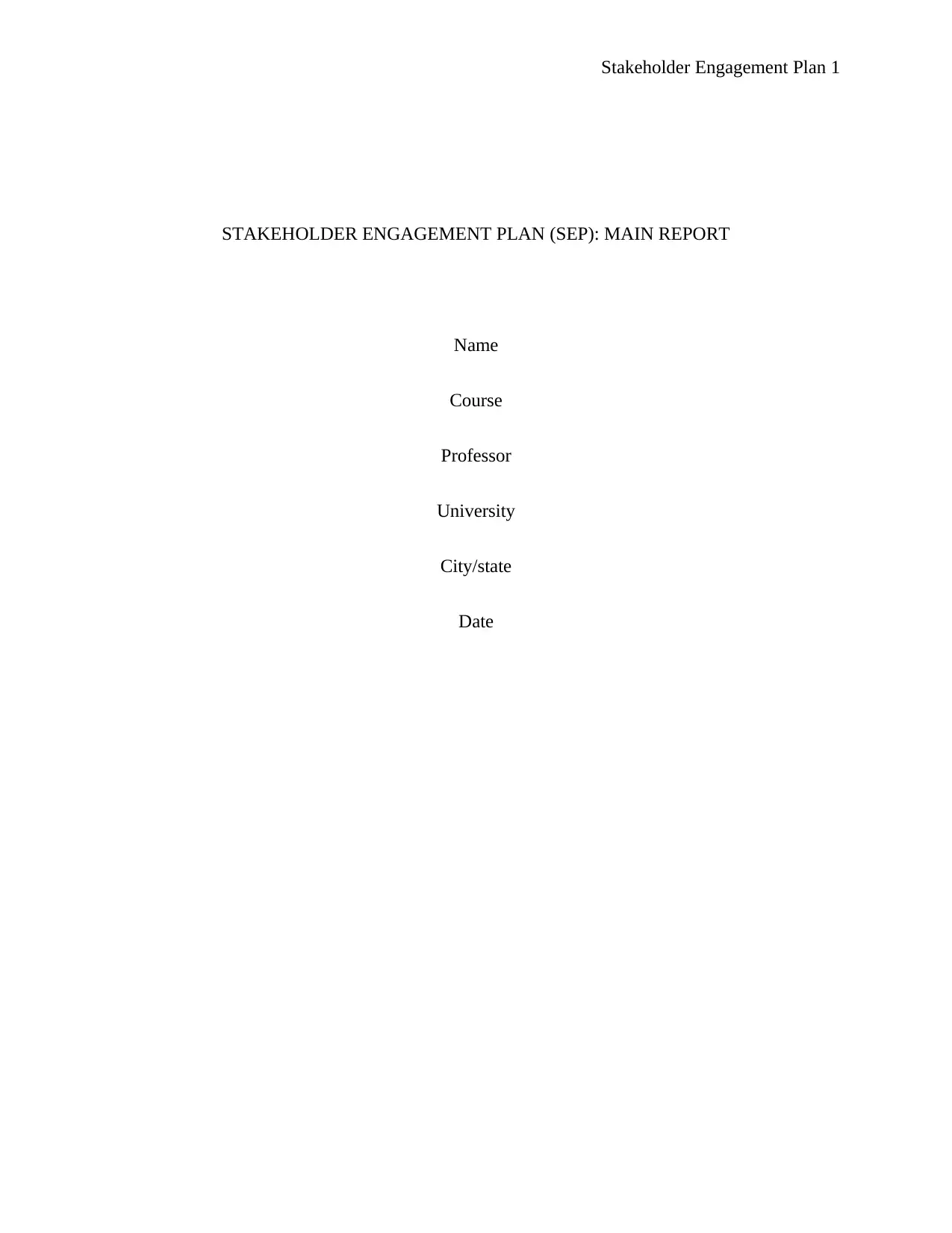
Stakeholder Engagement Plan 1
STAKEHOLDER ENGAGEMENT PLAN (SEP): MAIN REPORT
Name
Course
Professor
University
City/state
Date
STAKEHOLDER ENGAGEMENT PLAN (SEP): MAIN REPORT
Name
Course
Professor
University
City/state
Date
Paraphrase This Document
Need a fresh take? Get an instant paraphrase of this document with our AI Paraphraser
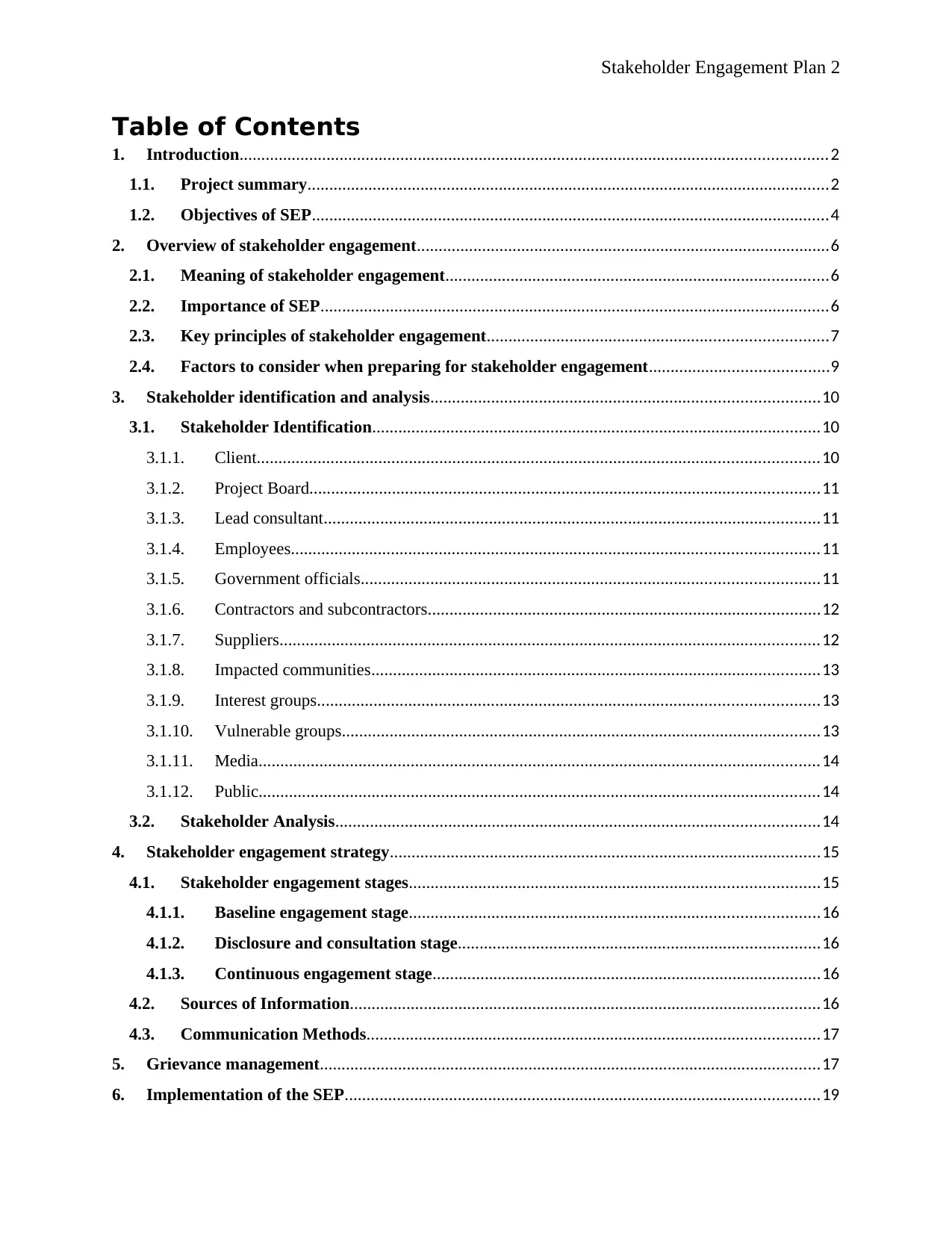
Stakeholder Engagement Plan 2
Table of Contents
1. Introduction.......................................................................................................................................2
1.1. Project summary........................................................................................................................2
1.2. Objectives of SEP.......................................................................................................................4
2. Overview of stakeholder engagement...............................................................................................6
2.1. Meaning of stakeholder engagement........................................................................................6
2.2. Importance of SEP.....................................................................................................................6
2.3. Key principles of stakeholder engagement..............................................................................7
2.4. Factors to consider when preparing for stakeholder engagement.........................................9
3. Stakeholder identification and analysis.........................................................................................10
3.1. Stakeholder Identification.......................................................................................................10
3.1.1. Client.................................................................................................................................10
3.1.2. Project Board.....................................................................................................................11
3.1.3. Lead consultant..................................................................................................................11
3.1.4. Employees.........................................................................................................................11
3.1.5. Government officials.........................................................................................................11
3.1.6. Contractors and subcontractors..........................................................................................12
3.1.7. Suppliers............................................................................................................................12
3.1.8. Impacted communities.......................................................................................................13
3.1.9. Interest groups...................................................................................................................13
3.1.10. Vulnerable groups..............................................................................................................13
3.1.11. Media.................................................................................................................................14
3.1.12. Public.................................................................................................................................14
3.2. Stakeholder Analysis...............................................................................................................14
4. Stakeholder engagement strategy...................................................................................................15
4.1. Stakeholder engagement stages..............................................................................................15
4.1.1. Baseline engagement stage..............................................................................................16
4.1.2. Disclosure and consultation stage...................................................................................16
4.1.3. Continuous engagement stage.........................................................................................16
4.2. Sources of Information............................................................................................................16
4.3. Communication Methods........................................................................................................17
5. Grievance management...................................................................................................................17
6. Implementation of the SEP.............................................................................................................19
Table of Contents
1. Introduction.......................................................................................................................................2
1.1. Project summary........................................................................................................................2
1.2. Objectives of SEP.......................................................................................................................4
2. Overview of stakeholder engagement...............................................................................................6
2.1. Meaning of stakeholder engagement........................................................................................6
2.2. Importance of SEP.....................................................................................................................6
2.3. Key principles of stakeholder engagement..............................................................................7
2.4. Factors to consider when preparing for stakeholder engagement.........................................9
3. Stakeholder identification and analysis.........................................................................................10
3.1. Stakeholder Identification.......................................................................................................10
3.1.1. Client.................................................................................................................................10
3.1.2. Project Board.....................................................................................................................11
3.1.3. Lead consultant..................................................................................................................11
3.1.4. Employees.........................................................................................................................11
3.1.5. Government officials.........................................................................................................11
3.1.6. Contractors and subcontractors..........................................................................................12
3.1.7. Suppliers............................................................................................................................12
3.1.8. Impacted communities.......................................................................................................13
3.1.9. Interest groups...................................................................................................................13
3.1.10. Vulnerable groups..............................................................................................................13
3.1.11. Media.................................................................................................................................14
3.1.12. Public.................................................................................................................................14
3.2. Stakeholder Analysis...............................................................................................................14
4. Stakeholder engagement strategy...................................................................................................15
4.1. Stakeholder engagement stages..............................................................................................15
4.1.1. Baseline engagement stage..............................................................................................16
4.1.2. Disclosure and consultation stage...................................................................................16
4.1.3. Continuous engagement stage.........................................................................................16
4.2. Sources of Information............................................................................................................16
4.3. Communication Methods........................................................................................................17
5. Grievance management...................................................................................................................17
6. Implementation of the SEP.............................................................................................................19
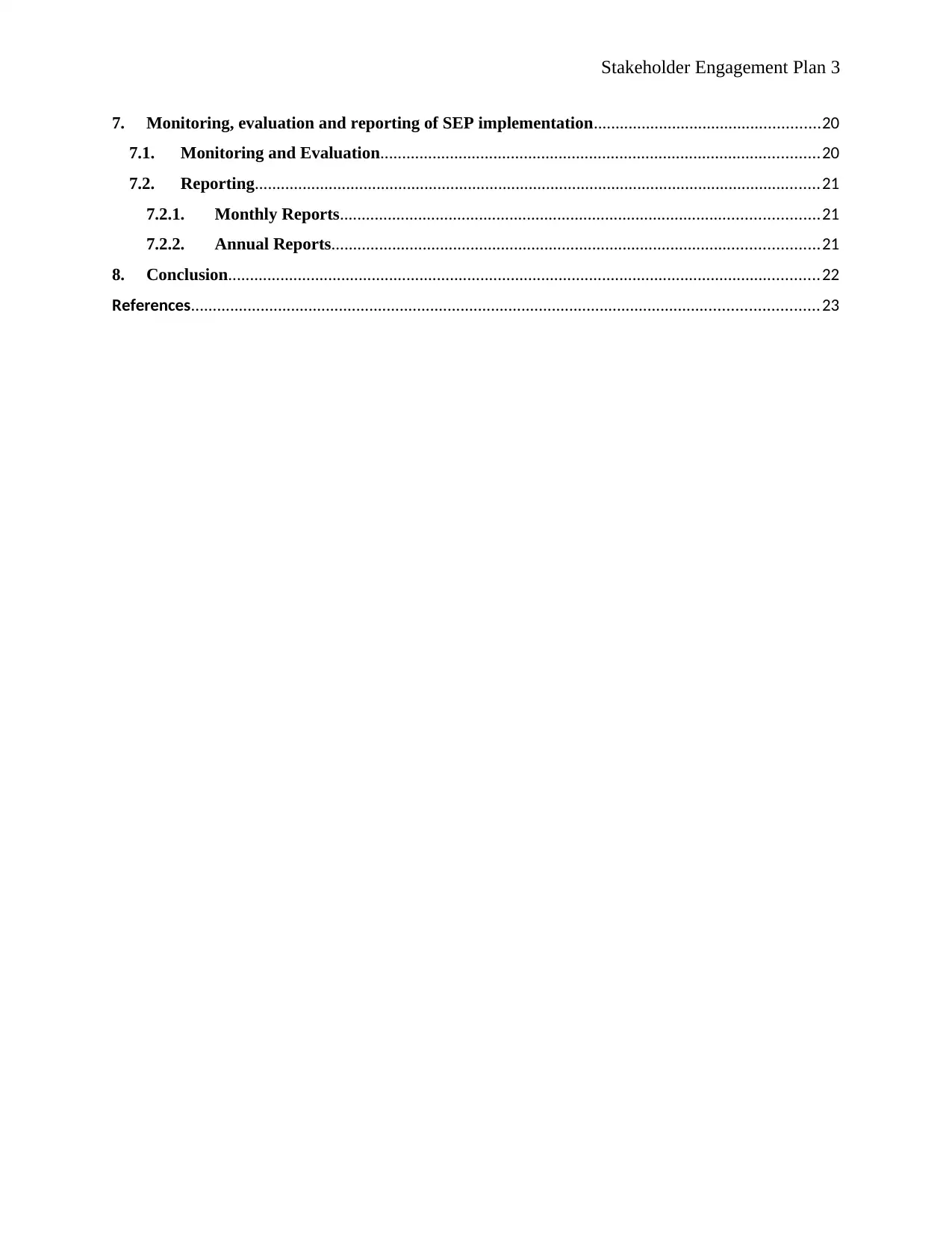
Stakeholder Engagement Plan 3
7. Monitoring, evaluation and reporting of SEP implementation....................................................20
7.1. Monitoring and Evaluation.....................................................................................................20
7.2. Reporting..................................................................................................................................21
7.2.1. Monthly Reports..............................................................................................................21
7.2.2. Annual Reports................................................................................................................21
8. Conclusion........................................................................................................................................22
References................................................................................................................................................23
7. Monitoring, evaluation and reporting of SEP implementation....................................................20
7.1. Monitoring and Evaluation.....................................................................................................20
7.2. Reporting..................................................................................................................................21
7.2.1. Monthly Reports..............................................................................................................21
7.2.2. Annual Reports................................................................................................................21
8. Conclusion........................................................................................................................................22
References................................................................................................................................................23
⊘ This is a preview!⊘
Do you want full access?
Subscribe today to unlock all pages.

Trusted by 1+ million students worldwide
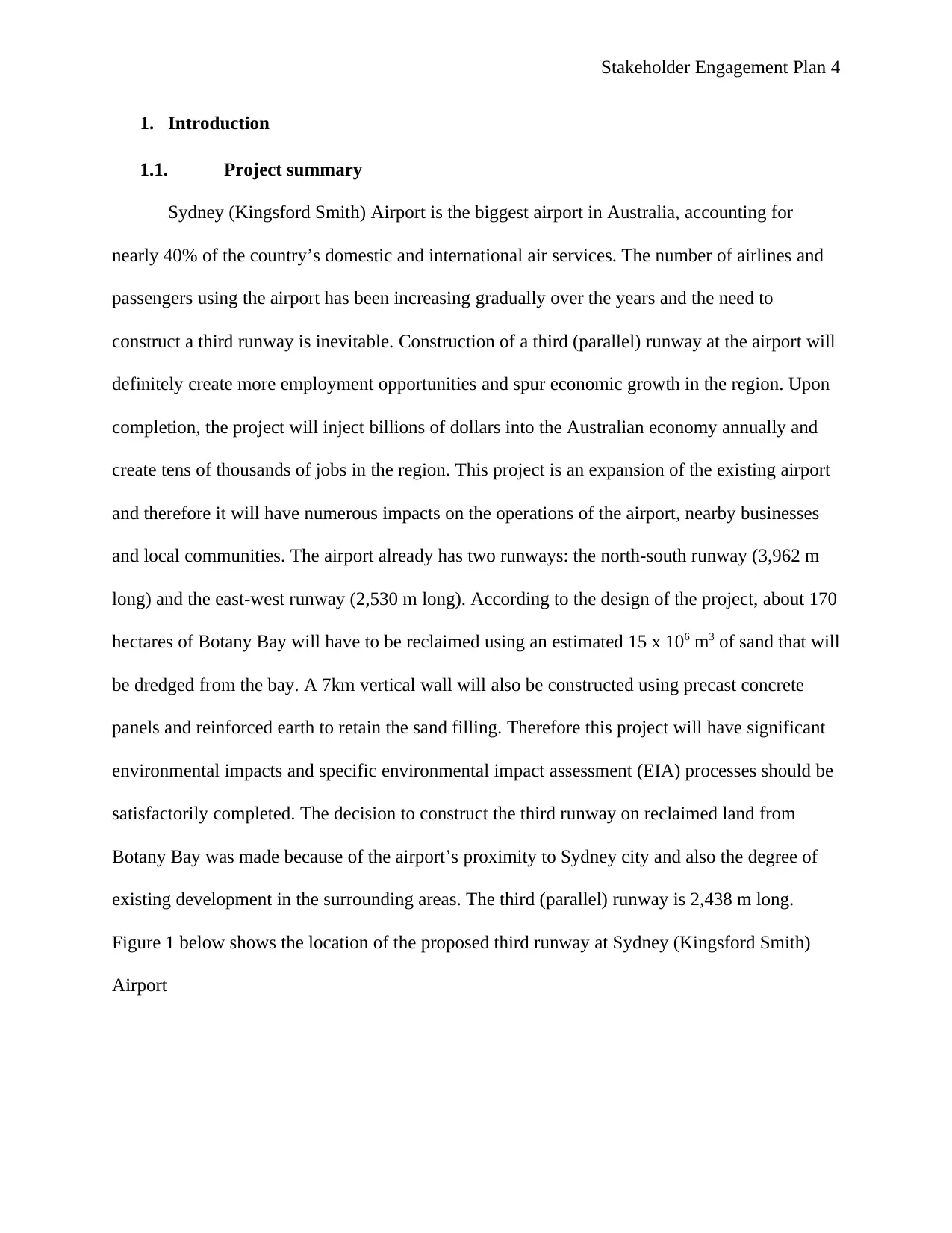
Stakeholder Engagement Plan 4
1. Introduction
1.1. Project summary
Sydney (Kingsford Smith) Airport is the biggest airport in Australia, accounting for
nearly 40% of the country’s domestic and international air services. The number of airlines and
passengers using the airport has been increasing gradually over the years and the need to
construct a third runway is inevitable. Construction of a third (parallel) runway at the airport will
definitely create more employment opportunities and spur economic growth in the region. Upon
completion, the project will inject billions of dollars into the Australian economy annually and
create tens of thousands of jobs in the region. This project is an expansion of the existing airport
and therefore it will have numerous impacts on the operations of the airport, nearby businesses
and local communities. The airport already has two runways: the north-south runway (3,962 m
long) and the east-west runway (2,530 m long). According to the design of the project, about 170
hectares of Botany Bay will have to be reclaimed using an estimated 15 x 106 m3 of sand that will
be dredged from the bay. A 7km vertical wall will also be constructed using precast concrete
panels and reinforced earth to retain the sand filling. Therefore this project will have significant
environmental impacts and specific environmental impact assessment (EIA) processes should be
satisfactorily completed. The decision to construct the third runway on reclaimed land from
Botany Bay was made because of the airport’s proximity to Sydney city and also the degree of
existing development in the surrounding areas. The third (parallel) runway is 2,438 m long.
Figure 1 below shows the location of the proposed third runway at Sydney (Kingsford Smith)
Airport
1. Introduction
1.1. Project summary
Sydney (Kingsford Smith) Airport is the biggest airport in Australia, accounting for
nearly 40% of the country’s domestic and international air services. The number of airlines and
passengers using the airport has been increasing gradually over the years and the need to
construct a third runway is inevitable. Construction of a third (parallel) runway at the airport will
definitely create more employment opportunities and spur economic growth in the region. Upon
completion, the project will inject billions of dollars into the Australian economy annually and
create tens of thousands of jobs in the region. This project is an expansion of the existing airport
and therefore it will have numerous impacts on the operations of the airport, nearby businesses
and local communities. The airport already has two runways: the north-south runway (3,962 m
long) and the east-west runway (2,530 m long). According to the design of the project, about 170
hectares of Botany Bay will have to be reclaimed using an estimated 15 x 106 m3 of sand that will
be dredged from the bay. A 7km vertical wall will also be constructed using precast concrete
panels and reinforced earth to retain the sand filling. Therefore this project will have significant
environmental impacts and specific environmental impact assessment (EIA) processes should be
satisfactorily completed. The decision to construct the third runway on reclaimed land from
Botany Bay was made because of the airport’s proximity to Sydney city and also the degree of
existing development in the surrounding areas. The third (parallel) runway is 2,438 m long.
Figure 1 below shows the location of the proposed third runway at Sydney (Kingsford Smith)
Airport
Paraphrase This Document
Need a fresh take? Get an instant paraphrase of this document with our AI Paraphraser
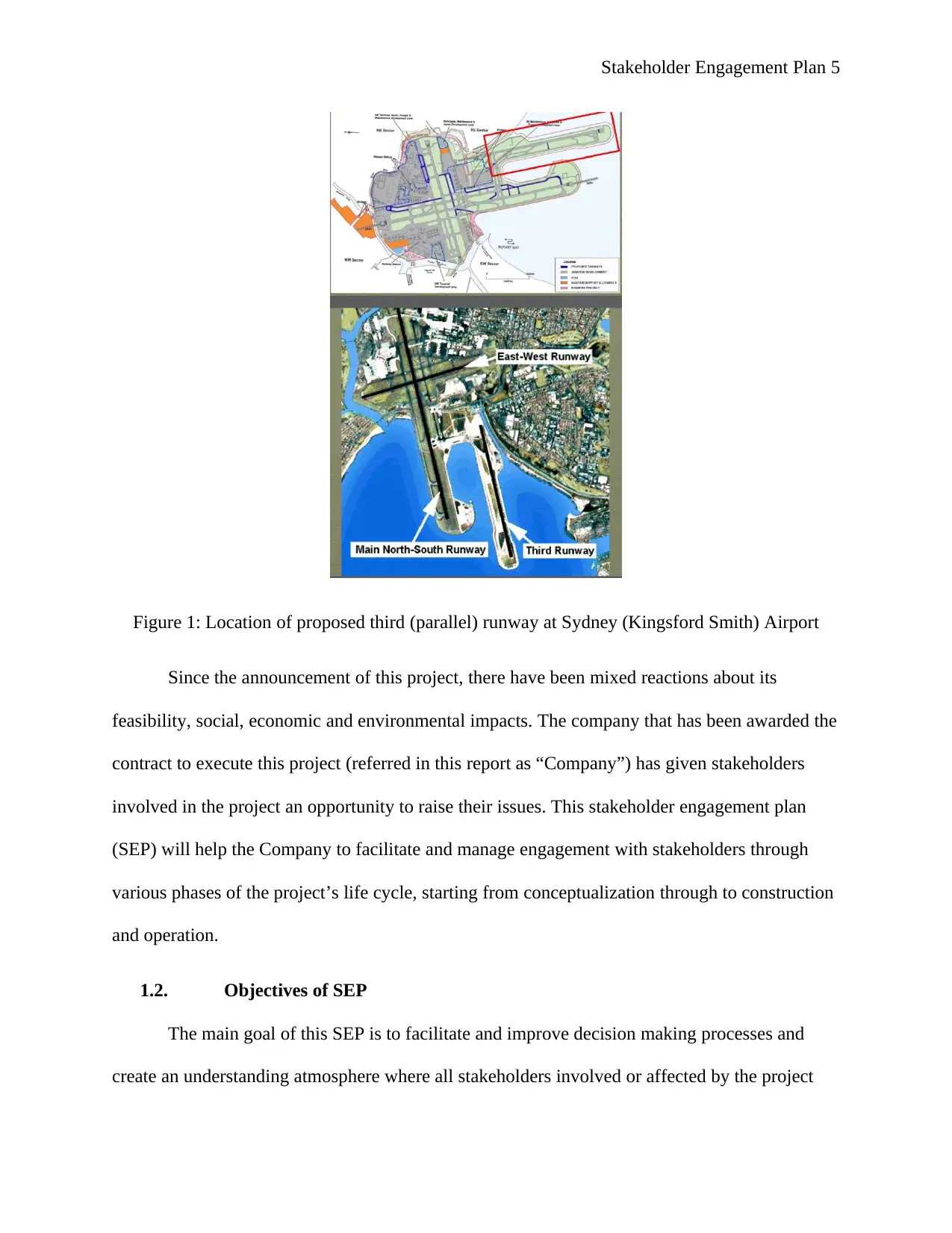
Stakeholder Engagement Plan 5
Figure 1: Location of proposed third (parallel) runway at Sydney (Kingsford Smith) Airport
Since the announcement of this project, there have been mixed reactions about its
feasibility, social, economic and environmental impacts. The company that has been awarded the
contract to execute this project (referred in this report as “Company”) has given stakeholders
involved in the project an opportunity to raise their issues. This stakeholder engagement plan
(SEP) will help the Company to facilitate and manage engagement with stakeholders through
various phases of the project’s life cycle, starting from conceptualization through to construction
and operation.
1.2. Objectives of SEP
The main goal of this SEP is to facilitate and improve decision making processes and
create an understanding atmosphere where all stakeholders involved or affected by the project
Figure 1: Location of proposed third (parallel) runway at Sydney (Kingsford Smith) Airport
Since the announcement of this project, there have been mixed reactions about its
feasibility, social, economic and environmental impacts. The company that has been awarded the
contract to execute this project (referred in this report as “Company”) has given stakeholders
involved in the project an opportunity to raise their issues. This stakeholder engagement plan
(SEP) will help the Company to facilitate and manage engagement with stakeholders through
various phases of the project’s life cycle, starting from conceptualization through to construction
and operation.
1.2. Objectives of SEP
The main goal of this SEP is to facilitate and improve decision making processes and
create an understanding atmosphere where all stakeholders involved or affected by the project
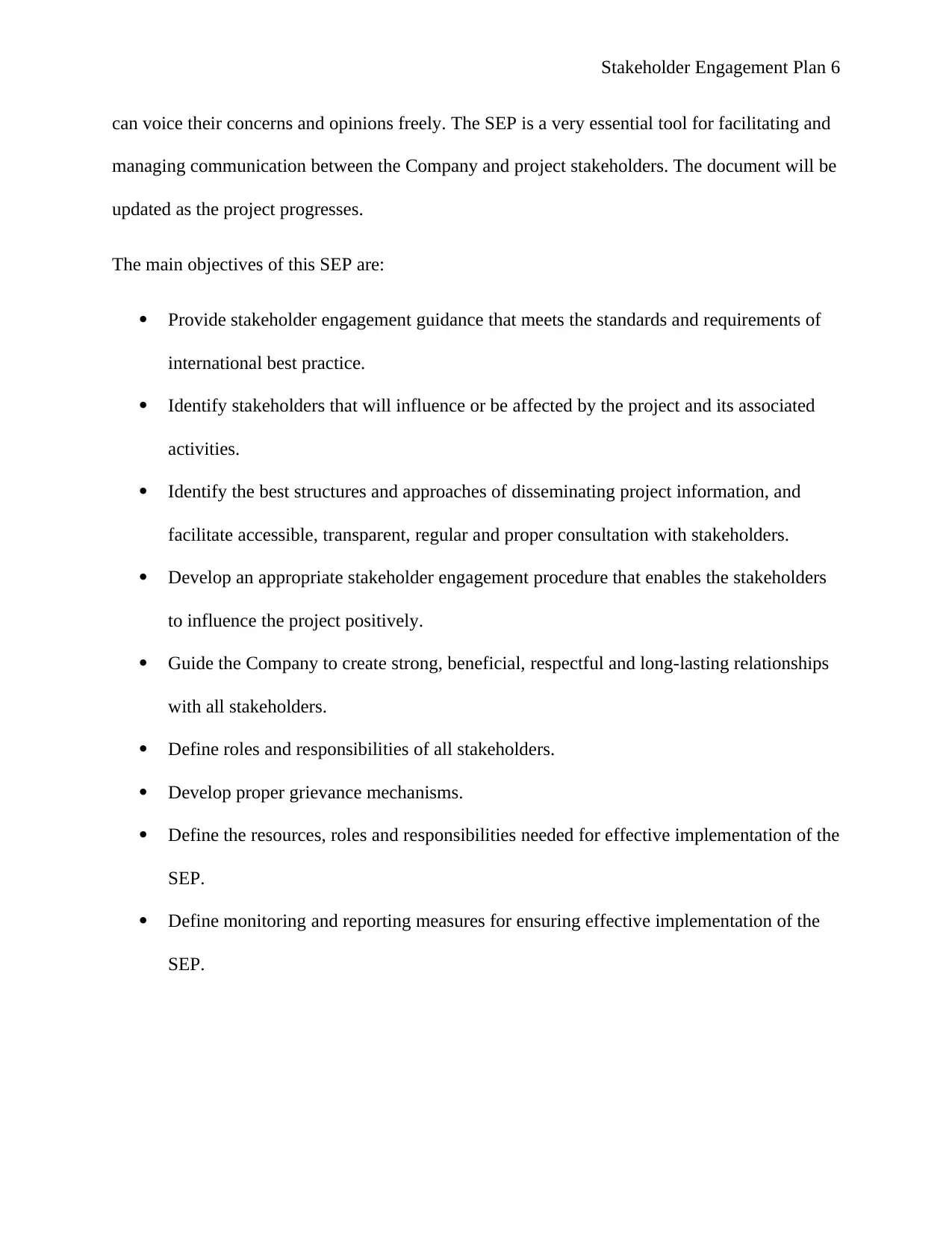
Stakeholder Engagement Plan 6
can voice their concerns and opinions freely. The SEP is a very essential tool for facilitating and
managing communication between the Company and project stakeholders. The document will be
updated as the project progresses.
The main objectives of this SEP are:
Provide stakeholder engagement guidance that meets the standards and requirements of
international best practice.
Identify stakeholders that will influence or be affected by the project and its associated
activities.
Identify the best structures and approaches of disseminating project information, and
facilitate accessible, transparent, regular and proper consultation with stakeholders.
Develop an appropriate stakeholder engagement procedure that enables the stakeholders
to influence the project positively.
Guide the Company to create strong, beneficial, respectful and long-lasting relationships
with all stakeholders.
Define roles and responsibilities of all stakeholders.
Develop proper grievance mechanisms.
Define the resources, roles and responsibilities needed for effective implementation of the
SEP.
Define monitoring and reporting measures for ensuring effective implementation of the
SEP.
can voice their concerns and opinions freely. The SEP is a very essential tool for facilitating and
managing communication between the Company and project stakeholders. The document will be
updated as the project progresses.
The main objectives of this SEP are:
Provide stakeholder engagement guidance that meets the standards and requirements of
international best practice.
Identify stakeholders that will influence or be affected by the project and its associated
activities.
Identify the best structures and approaches of disseminating project information, and
facilitate accessible, transparent, regular and proper consultation with stakeholders.
Develop an appropriate stakeholder engagement procedure that enables the stakeholders
to influence the project positively.
Guide the Company to create strong, beneficial, respectful and long-lasting relationships
with all stakeholders.
Define roles and responsibilities of all stakeholders.
Develop proper grievance mechanisms.
Define the resources, roles and responsibilities needed for effective implementation of the
SEP.
Define monitoring and reporting measures for ensuring effective implementation of the
SEP.
⊘ This is a preview!⊘
Do you want full access?
Subscribe today to unlock all pages.

Trusted by 1+ million students worldwide
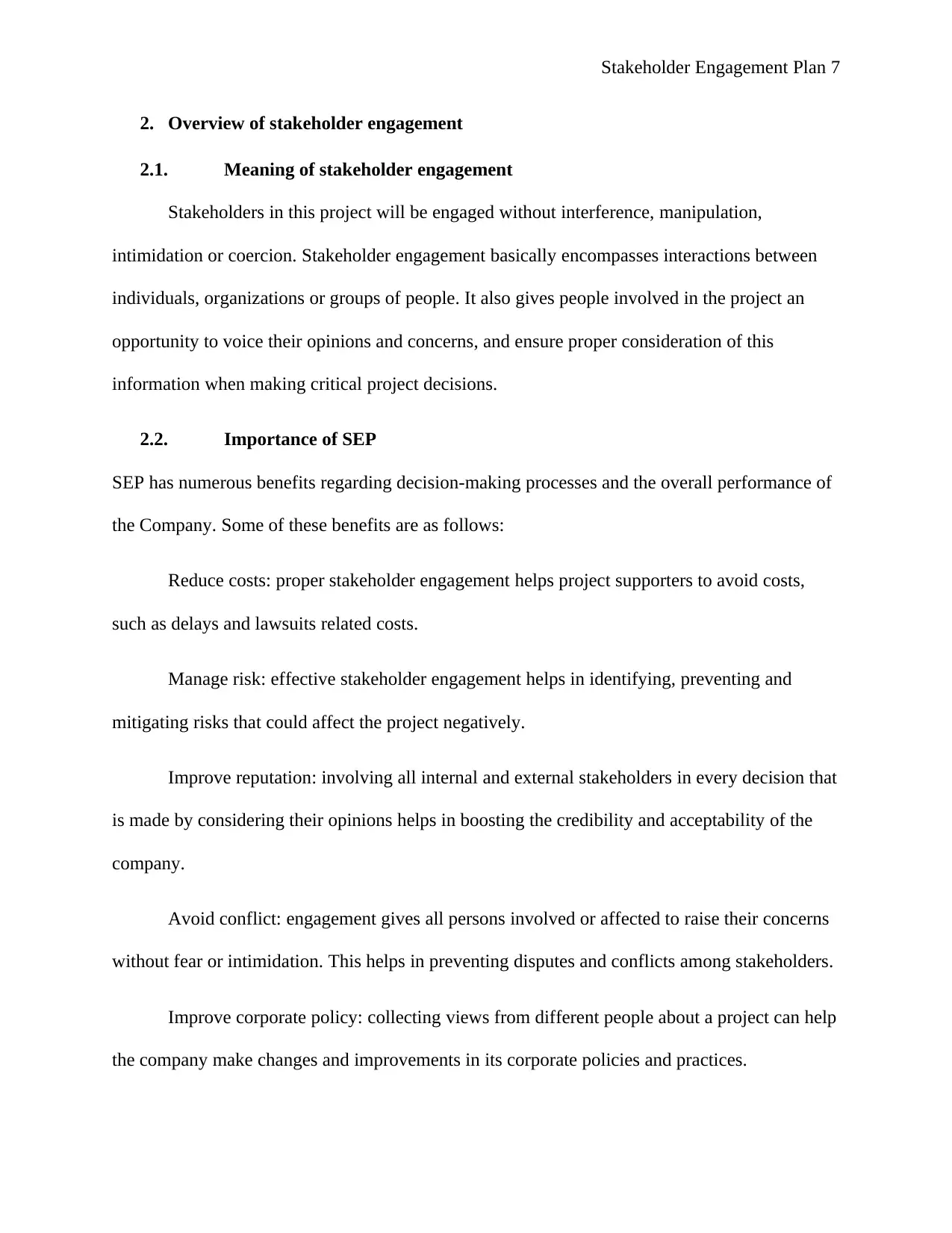
Stakeholder Engagement Plan 7
2. Overview of stakeholder engagement
2.1. Meaning of stakeholder engagement
Stakeholders in this project will be engaged without interference, manipulation,
intimidation or coercion. Stakeholder engagement basically encompasses interactions between
individuals, organizations or groups of people. It also gives people involved in the project an
opportunity to voice their opinions and concerns, and ensure proper consideration of this
information when making critical project decisions.
2.2. Importance of SEP
SEP has numerous benefits regarding decision-making processes and the overall performance of
the Company. Some of these benefits are as follows:
Reduce costs: proper stakeholder engagement helps project supporters to avoid costs,
such as delays and lawsuits related costs.
Manage risk: effective stakeholder engagement helps in identifying, preventing and
mitigating risks that could affect the project negatively.
Improve reputation: involving all internal and external stakeholders in every decision that
is made by considering their opinions helps in boosting the credibility and acceptability of the
company.
Avoid conflict: engagement gives all persons involved or affected to raise their concerns
without fear or intimidation. This helps in preventing disputes and conflicts among stakeholders.
Improve corporate policy: collecting views from different people about a project can help
the company make changes and improvements in its corporate policies and practices.
2. Overview of stakeholder engagement
2.1. Meaning of stakeholder engagement
Stakeholders in this project will be engaged without interference, manipulation,
intimidation or coercion. Stakeholder engagement basically encompasses interactions between
individuals, organizations or groups of people. It also gives people involved in the project an
opportunity to voice their opinions and concerns, and ensure proper consideration of this
information when making critical project decisions.
2.2. Importance of SEP
SEP has numerous benefits regarding decision-making processes and the overall performance of
the Company. Some of these benefits are as follows:
Reduce costs: proper stakeholder engagement helps project supporters to avoid costs,
such as delays and lawsuits related costs.
Manage risk: effective stakeholder engagement helps in identifying, preventing and
mitigating risks that could affect the project negatively.
Improve reputation: involving all internal and external stakeholders in every decision that
is made by considering their opinions helps in boosting the credibility and acceptability of the
company.
Avoid conflict: engagement gives all persons involved or affected to raise their concerns
without fear or intimidation. This helps in preventing disputes and conflicts among stakeholders.
Improve corporate policy: collecting views from different people about a project can help
the company make changes and improvements in its corporate policies and practices.
Paraphrase This Document
Need a fresh take? Get an instant paraphrase of this document with our AI Paraphraser
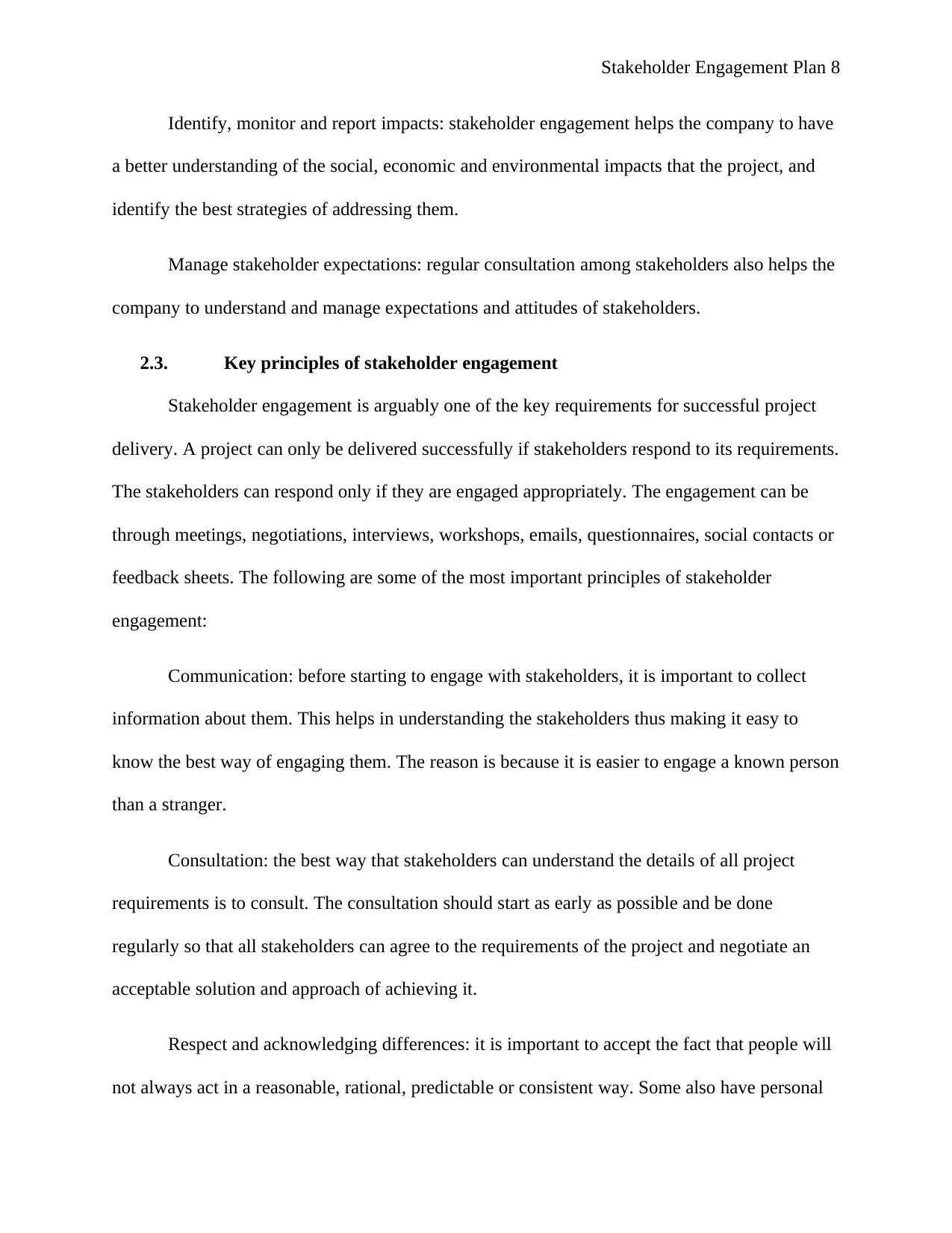
Stakeholder Engagement Plan 8
Identify, monitor and report impacts: stakeholder engagement helps the company to have
a better understanding of the social, economic and environmental impacts that the project, and
identify the best strategies of addressing them.
Manage stakeholder expectations: regular consultation among stakeholders also helps the
company to understand and manage expectations and attitudes of stakeholders.
2.3. Key principles of stakeholder engagement
Stakeholder engagement is arguably one of the key requirements for successful project
delivery. A project can only be delivered successfully if stakeholders respond to its requirements.
The stakeholders can respond only if they are engaged appropriately. The engagement can be
through meetings, negotiations, interviews, workshops, emails, questionnaires, social contacts or
feedback sheets. The following are some of the most important principles of stakeholder
engagement:
Communication: before starting to engage with stakeholders, it is important to collect
information about them. This helps in understanding the stakeholders thus making it easy to
know the best way of engaging them. The reason is because it is easier to engage a known person
than a stranger.
Consultation: the best way that stakeholders can understand the details of all project
requirements is to consult. The consultation should start as early as possible and be done
regularly so that all stakeholders can agree to the requirements of the project and negotiate an
acceptable solution and approach of achieving it.
Respect and acknowledging differences: it is important to accept the fact that people will
not always act in a reasonable, rational, predictable or consistent way. Some also have personal
Identify, monitor and report impacts: stakeholder engagement helps the company to have
a better understanding of the social, economic and environmental impacts that the project, and
identify the best strategies of addressing them.
Manage stakeholder expectations: regular consultation among stakeholders also helps the
company to understand and manage expectations and attitudes of stakeholders.
2.3. Key principles of stakeholder engagement
Stakeholder engagement is arguably one of the key requirements for successful project
delivery. A project can only be delivered successfully if stakeholders respond to its requirements.
The stakeholders can respond only if they are engaged appropriately. The engagement can be
through meetings, negotiations, interviews, workshops, emails, questionnaires, social contacts or
feedback sheets. The following are some of the most important principles of stakeholder
engagement:
Communication: before starting to engage with stakeholders, it is important to collect
information about them. This helps in understanding the stakeholders thus making it easy to
know the best way of engaging them. The reason is because it is easier to engage a known person
than a stranger.
Consultation: the best way that stakeholders can understand the details of all project
requirements is to consult. The consultation should start as early as possible and be done
regularly so that all stakeholders can agree to the requirements of the project and negotiate an
acceptable solution and approach of achieving it.
Respect and acknowledging differences: it is important to accept the fact that people will
not always act in a reasonable, rational, predictable or consistent way. Some also have personal
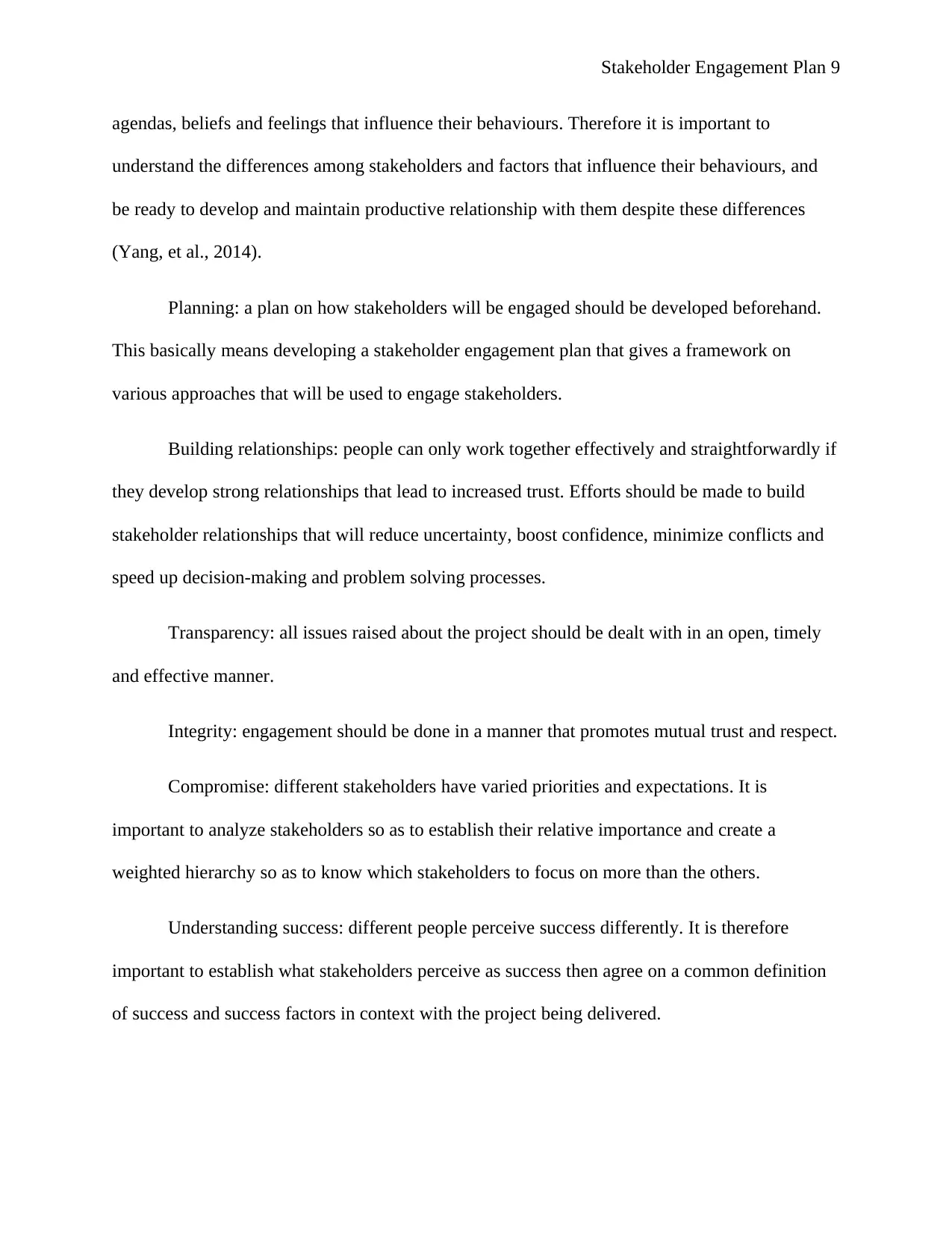
Stakeholder Engagement Plan 9
agendas, beliefs and feelings that influence their behaviours. Therefore it is important to
understand the differences among stakeholders and factors that influence their behaviours, and
be ready to develop and maintain productive relationship with them despite these differences
(Yang, et al., 2014).
Planning: a plan on how stakeholders will be engaged should be developed beforehand.
This basically means developing a stakeholder engagement plan that gives a framework on
various approaches that will be used to engage stakeholders.
Building relationships: people can only work together effectively and straightforwardly if
they develop strong relationships that lead to increased trust. Efforts should be made to build
stakeholder relationships that will reduce uncertainty, boost confidence, minimize conflicts and
speed up decision-making and problem solving processes.
Transparency: all issues raised about the project should be dealt with in an open, timely
and effective manner.
Integrity: engagement should be done in a manner that promotes mutual trust and respect.
Compromise: different stakeholders have varied priorities and expectations. It is
important to analyze stakeholders so as to establish their relative importance and create a
weighted hierarchy so as to know which stakeholders to focus on more than the others.
Understanding success: different people perceive success differently. It is therefore
important to establish what stakeholders perceive as success then agree on a common definition
of success and success factors in context with the project being delivered.
agendas, beliefs and feelings that influence their behaviours. Therefore it is important to
understand the differences among stakeholders and factors that influence their behaviours, and
be ready to develop and maintain productive relationship with them despite these differences
(Yang, et al., 2014).
Planning: a plan on how stakeholders will be engaged should be developed beforehand.
This basically means developing a stakeholder engagement plan that gives a framework on
various approaches that will be used to engage stakeholders.
Building relationships: people can only work together effectively and straightforwardly if
they develop strong relationships that lead to increased trust. Efforts should be made to build
stakeholder relationships that will reduce uncertainty, boost confidence, minimize conflicts and
speed up decision-making and problem solving processes.
Transparency: all issues raised about the project should be dealt with in an open, timely
and effective manner.
Integrity: engagement should be done in a manner that promotes mutual trust and respect.
Compromise: different stakeholders have varied priorities and expectations. It is
important to analyze stakeholders so as to establish their relative importance and create a
weighted hierarchy so as to know which stakeholders to focus on more than the others.
Understanding success: different people perceive success differently. It is therefore
important to establish what stakeholders perceive as success then agree on a common definition
of success and success factors in context with the project being delivered.
⊘ This is a preview!⊘
Do you want full access?
Subscribe today to unlock all pages.

Trusted by 1+ million students worldwide
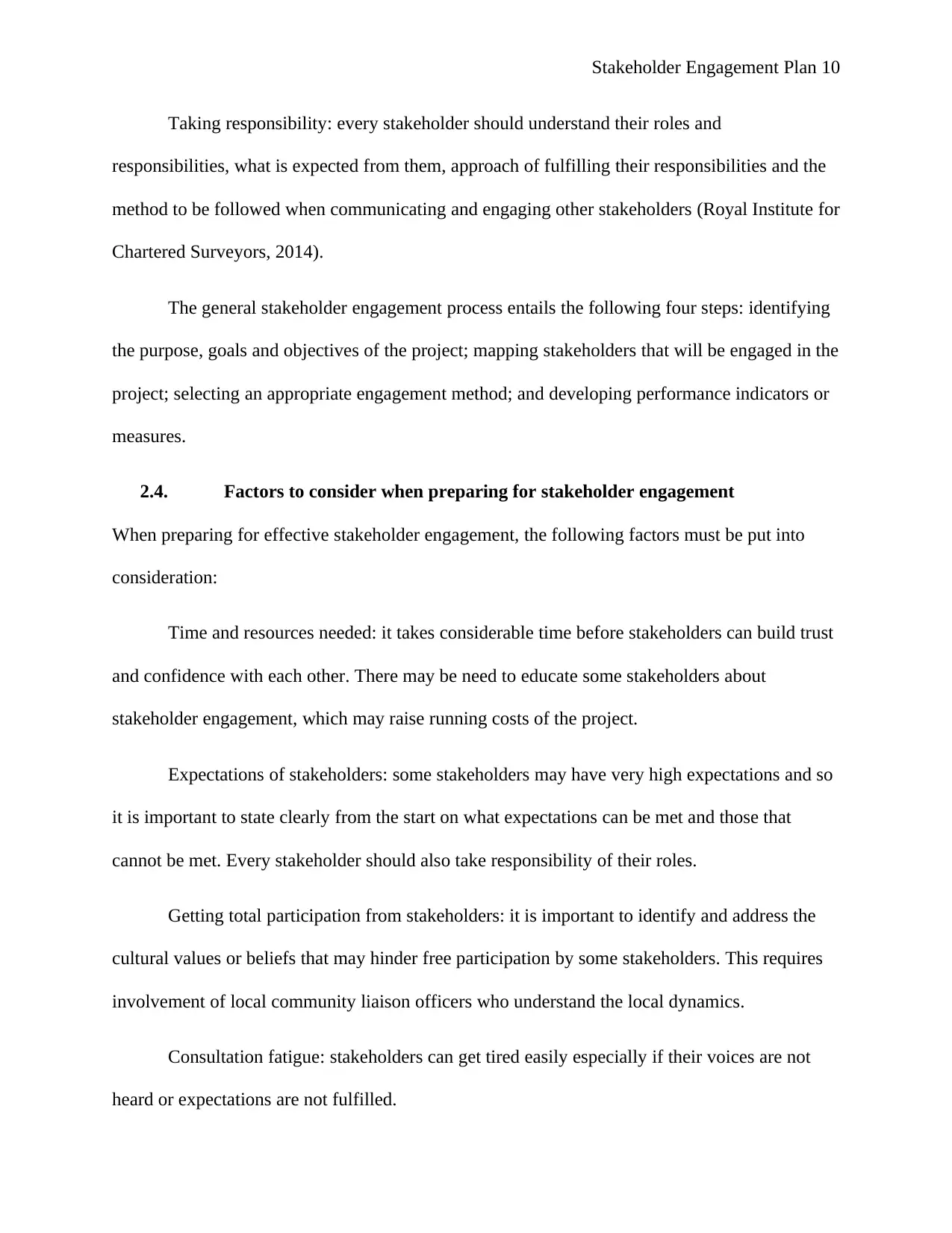
Stakeholder Engagement Plan 10
Taking responsibility: every stakeholder should understand their roles and
responsibilities, what is expected from them, approach of fulfilling their responsibilities and the
method to be followed when communicating and engaging other stakeholders (Royal Institute for
Chartered Surveyors, 2014).
The general stakeholder engagement process entails the following four steps: identifying
the purpose, goals and objectives of the project; mapping stakeholders that will be engaged in the
project; selecting an appropriate engagement method; and developing performance indicators or
measures.
2.4. Factors to consider when preparing for stakeholder engagement
When preparing for effective stakeholder engagement, the following factors must be put into
consideration:
Time and resources needed: it takes considerable time before stakeholders can build trust
and confidence with each other. There may be need to educate some stakeholders about
stakeholder engagement, which may raise running costs of the project.
Expectations of stakeholders: some stakeholders may have very high expectations and so
it is important to state clearly from the start on what expectations can be met and those that
cannot be met. Every stakeholder should also take responsibility of their roles.
Getting total participation from stakeholders: it is important to identify and address the
cultural values or beliefs that may hinder free participation by some stakeholders. This requires
involvement of local community liaison officers who understand the local dynamics.
Consultation fatigue: stakeholders can get tired easily especially if their voices are not
heard or expectations are not fulfilled.
Taking responsibility: every stakeholder should understand their roles and
responsibilities, what is expected from them, approach of fulfilling their responsibilities and the
method to be followed when communicating and engaging other stakeholders (Royal Institute for
Chartered Surveyors, 2014).
The general stakeholder engagement process entails the following four steps: identifying
the purpose, goals and objectives of the project; mapping stakeholders that will be engaged in the
project; selecting an appropriate engagement method; and developing performance indicators or
measures.
2.4. Factors to consider when preparing for stakeholder engagement
When preparing for effective stakeholder engagement, the following factors must be put into
consideration:
Time and resources needed: it takes considerable time before stakeholders can build trust
and confidence with each other. There may be need to educate some stakeholders about
stakeholder engagement, which may raise running costs of the project.
Expectations of stakeholders: some stakeholders may have very high expectations and so
it is important to state clearly from the start on what expectations can be met and those that
cannot be met. Every stakeholder should also take responsibility of their roles.
Getting total participation from stakeholders: it is important to identify and address the
cultural values or beliefs that may hinder free participation by some stakeholders. This requires
involvement of local community liaison officers who understand the local dynamics.
Consultation fatigue: stakeholders can get tired easily especially if their voices are not
heard or expectations are not fulfilled.
Paraphrase This Document
Need a fresh take? Get an instant paraphrase of this document with our AI Paraphraser
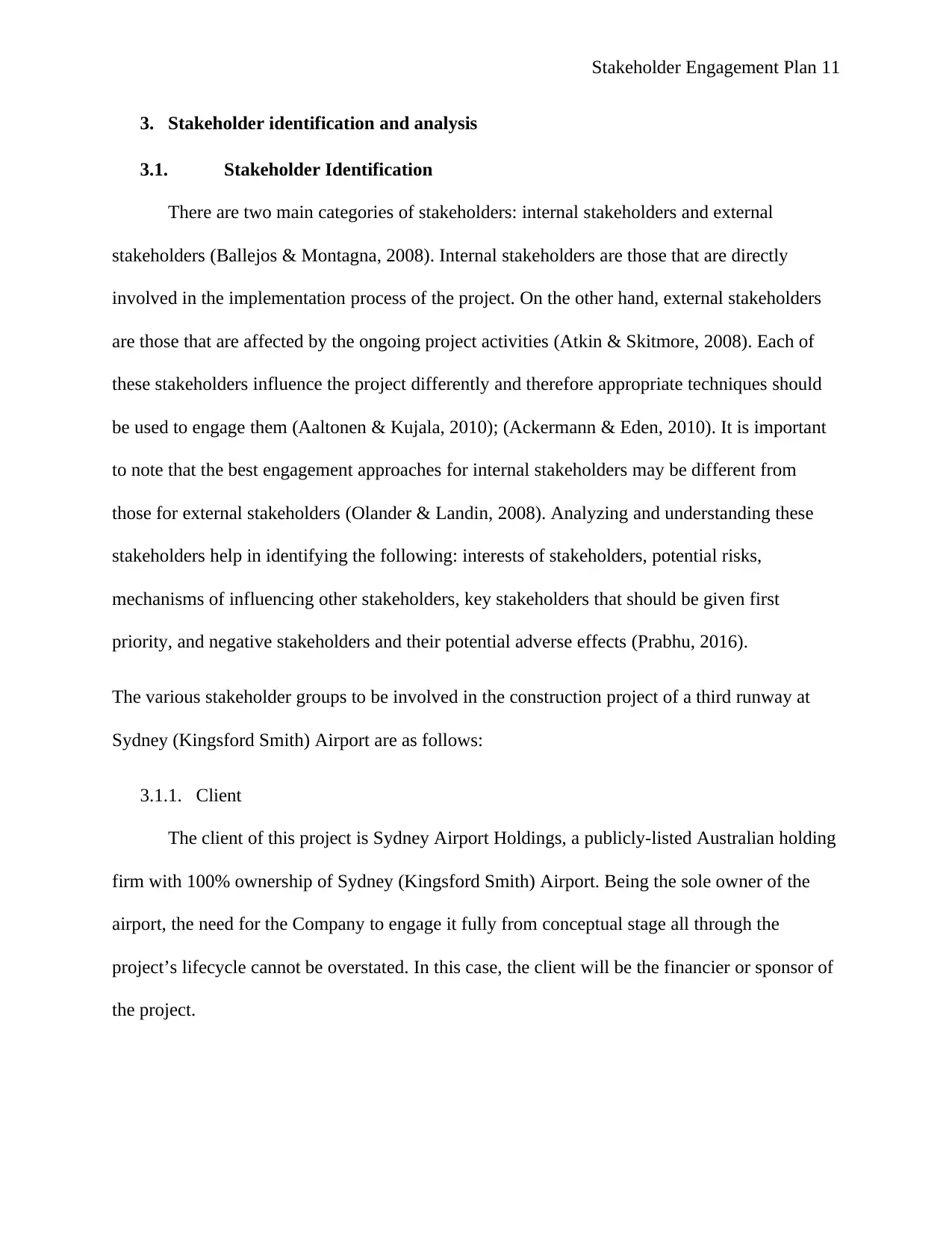
Stakeholder Engagement Plan 11
3. Stakeholder identification and analysis
3.1. Stakeholder Identification
There are two main categories of stakeholders: internal stakeholders and external
stakeholders (Ballejos & Montagna, 2008). Internal stakeholders are those that are directly
involved in the implementation process of the project. On the other hand, external stakeholders
are those that are affected by the ongoing project activities (Atkin & Skitmore, 2008). Each of
these stakeholders influence the project differently and therefore appropriate techniques should
be used to engage them (Aaltonen & Kujala, 2010); (Ackermann & Eden, 2010). It is important
to note that the best engagement approaches for internal stakeholders may be different from
those for external stakeholders (Olander & Landin, 2008). Analyzing and understanding these
stakeholders help in identifying the following: interests of stakeholders, potential risks,
mechanisms of influencing other stakeholders, key stakeholders that should be given first
priority, and negative stakeholders and their potential adverse effects (Prabhu, 2016).
The various stakeholder groups to be involved in the construction project of a third runway at
Sydney (Kingsford Smith) Airport are as follows:
3.1.1. Client
The client of this project is Sydney Airport Holdings, a publicly-listed Australian holding
firm with 100% ownership of Sydney (Kingsford Smith) Airport. Being the sole owner of the
airport, the need for the Company to engage it fully from conceptual stage all through the
project’s lifecycle cannot be overstated. In this case, the client will be the financier or sponsor of
the project.
3. Stakeholder identification and analysis
3.1. Stakeholder Identification
There are two main categories of stakeholders: internal stakeholders and external
stakeholders (Ballejos & Montagna, 2008). Internal stakeholders are those that are directly
involved in the implementation process of the project. On the other hand, external stakeholders
are those that are affected by the ongoing project activities (Atkin & Skitmore, 2008). Each of
these stakeholders influence the project differently and therefore appropriate techniques should
be used to engage them (Aaltonen & Kujala, 2010); (Ackermann & Eden, 2010). It is important
to note that the best engagement approaches for internal stakeholders may be different from
those for external stakeholders (Olander & Landin, 2008). Analyzing and understanding these
stakeholders help in identifying the following: interests of stakeholders, potential risks,
mechanisms of influencing other stakeholders, key stakeholders that should be given first
priority, and negative stakeholders and their potential adverse effects (Prabhu, 2016).
The various stakeholder groups to be involved in the construction project of a third runway at
Sydney (Kingsford Smith) Airport are as follows:
3.1.1. Client
The client of this project is Sydney Airport Holdings, a publicly-listed Australian holding
firm with 100% ownership of Sydney (Kingsford Smith) Airport. Being the sole owner of the
airport, the need for the Company to engage it fully from conceptual stage all through the
project’s lifecycle cannot be overstated. In this case, the client will be the financier or sponsor of
the project.
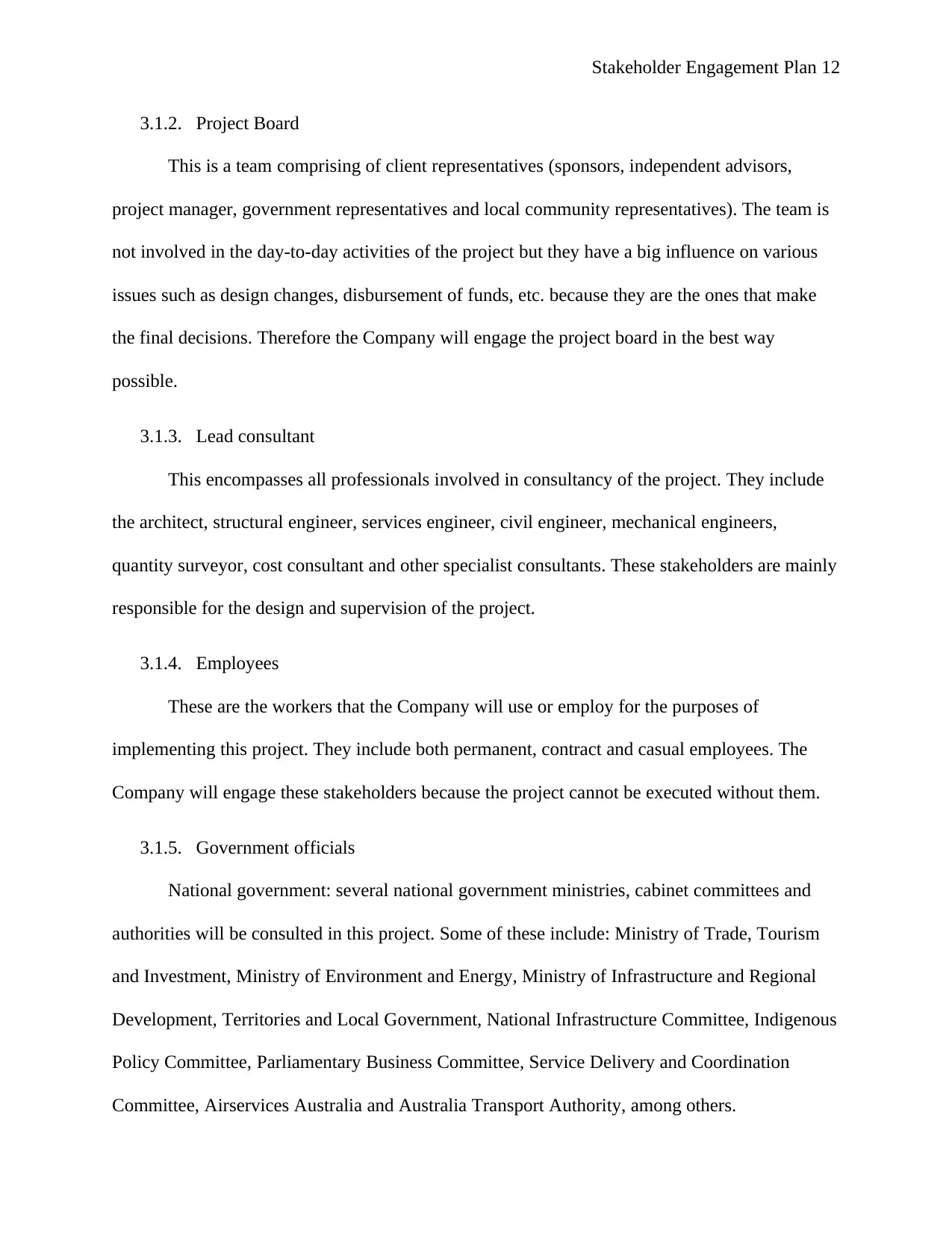
Stakeholder Engagement Plan 12
3.1.2. Project Board
This is a team comprising of client representatives (sponsors, independent advisors,
project manager, government representatives and local community representatives). The team is
not involved in the day-to-day activities of the project but they have a big influence on various
issues such as design changes, disbursement of funds, etc. because they are the ones that make
the final decisions. Therefore the Company will engage the project board in the best way
possible.
3.1.3. Lead consultant
This encompasses all professionals involved in consultancy of the project. They include
the architect, structural engineer, services engineer, civil engineer, mechanical engineers,
quantity surveyor, cost consultant and other specialist consultants. These stakeholders are mainly
responsible for the design and supervision of the project.
3.1.4. Employees
These are the workers that the Company will use or employ for the purposes of
implementing this project. They include both permanent, contract and casual employees. The
Company will engage these stakeholders because the project cannot be executed without them.
3.1.5. Government officials
National government: several national government ministries, cabinet committees and
authorities will be consulted in this project. Some of these include: Ministry of Trade, Tourism
and Investment, Ministry of Environment and Energy, Ministry of Infrastructure and Regional
Development, Territories and Local Government, National Infrastructure Committee, Indigenous
Policy Committee, Parliamentary Business Committee, Service Delivery and Coordination
Committee, Airservices Australia and Australia Transport Authority, among others.
3.1.2. Project Board
This is a team comprising of client representatives (sponsors, independent advisors,
project manager, government representatives and local community representatives). The team is
not involved in the day-to-day activities of the project but they have a big influence on various
issues such as design changes, disbursement of funds, etc. because they are the ones that make
the final decisions. Therefore the Company will engage the project board in the best way
possible.
3.1.3. Lead consultant
This encompasses all professionals involved in consultancy of the project. They include
the architect, structural engineer, services engineer, civil engineer, mechanical engineers,
quantity surveyor, cost consultant and other specialist consultants. These stakeholders are mainly
responsible for the design and supervision of the project.
3.1.4. Employees
These are the workers that the Company will use or employ for the purposes of
implementing this project. They include both permanent, contract and casual employees. The
Company will engage these stakeholders because the project cannot be executed without them.
3.1.5. Government officials
National government: several national government ministries, cabinet committees and
authorities will be consulted in this project. Some of these include: Ministry of Trade, Tourism
and Investment, Ministry of Environment and Energy, Ministry of Infrastructure and Regional
Development, Territories and Local Government, National Infrastructure Committee, Indigenous
Policy Committee, Parliamentary Business Committee, Service Delivery and Coordination
Committee, Airservices Australia and Australia Transport Authority, among others.
⊘ This is a preview!⊘
Do you want full access?
Subscribe today to unlock all pages.

Trusted by 1+ million students worldwide
1 out of 26
Your All-in-One AI-Powered Toolkit for Academic Success.
+13062052269
info@desklib.com
Available 24*7 on WhatsApp / Email
![[object Object]](/_next/static/media/star-bottom.7253800d.svg)
Unlock your academic potential
Copyright © 2020–2025 A2Z Services. All Rights Reserved. Developed and managed by ZUCOL.